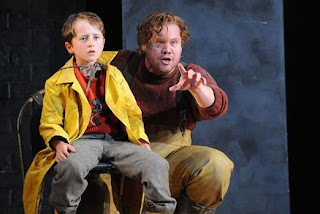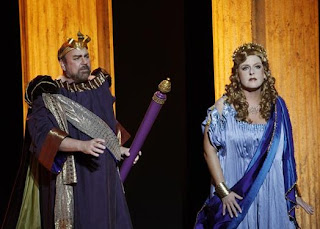Aida | Opera Australia
Written by Adrienne Gross |
Thursday, 23 July 2009
|
 |
Above - Michael Lewis (Amonasro) & Tamara Wilson (Aida) kneel before David Parkin (The King).
Photos - Branco Gaica
Opera Australia’s production of
Aida is like a beautiful porcelain doll: fun to dress up in pretty dresses, but without the ability to talk. The sumptuous costumes, dynamic set design and effective lighting bring zazzle to technically perfect performers, but the acting and character believability was lacking. Overall
Giuseppe Verdi’s Aida is one of those operas to see in one’s lifetime, and with this production, you’ll go home impressed with the cleverness - but you probably won’t shed a tear at the end.
Set in the time of the pharaohs,
Aida has four acts over three hours and is one of the grandest Italian-language operas to fill stages worldwide since its premiere in 1871. As with any melodrama, there are love triangles, family feuds, warring nations and a tragic heroine woven into plot twists and turns. The first act opens with warrior wannabe
Ramadès being granted his wish to lead the Egyptian army against Ethiopia. Meanwhile, the Egyptian princess
Amneris pines for
Ramadès, and suspects a rival female attention - later confirmed to be her slave, the captive Ethiopian princess,
Aida. After winning the battle, the
pharaoh promises
Ramadès anything he wants. The story continues with betrayal, dilemmas and the tragic finale.
Overall,
Aida is a bit like the most un-politically correct dinner party you can have: where sex, politics and religion are spread out on the table as an audience feast. Indeed, the direction by
Graeme Murphy gave the effect that we were the gods, watching the humans create a mess of their lives.
And what a mess - imagine you had to choose between the love of your country and your lover. No wonder
Verdi littered the songs with such extreme words as ‘let death be their just destination’ and ‘helpless children slain.’ That level of emotion means expectations are high for some tormented stage presence so powerful that the visceral pain of the character should be spilled into voice and physicality. This is the basis of empathy, a bridge between audience and actor, without which one may as well be watching the midday movie with some Tim Tams. Thus, I was a little disappointed at the disconnection been the performers and their roles. There is no doubting the technical skill of the voices - pure and controlled - but the interaction between characters was like individuals who happened to be on stage with someone else. There are many reasons why this lacking in emotional dialogue exists: mis-casting, minimalist direction, even the plot itself.
However, each performer still gave competent individuality to their roles.
Amneris, as played by
Milijana Nikolic was the standout, embracing the pharaoh’s daughter role with panache; exuding richness, haughtiness and class.
Aida (
Tamara Wilson) came across as a lost little girl, quivering with indecision at her fate.
Dongwon Shin’s Ramadès held himself grandly and hit the long notes without fault. The supporting characters of
High Priest (
Jud Arthur) and
King of Egypt (
David Parkin) performed to their roles with sternness, with
Michael Lewis popping with verve as the impassioned patriotic King of Ethiopia
Amonasro, who wanted to win at any price. Perhaps that embodiment of emotion is what the other characters needed, in the way they walked, stood and gestured.
Between all the main characters were the dancers and the chorus of men and women. The dancers made for delightful jumpstarts, popping around the stage with grace and clever choreography. The chorus was in tune and provided a background humming of either doom or elation as plot required. Some of the stage action though seemed bit unpolished, as movements weren’t quite so in-time and symmetrical as was most likely intended.
If this production of
Aida were a film, surely the Oscar would go to creative associate
Janet Vernon and the set designer
Roger Kirk, the latter also designing the magnificent costumes. Their combined talents transformed the small stage into a spectacular arrangement of simple and effective scene transitions and dynamic movement. The lighting design by
Damien Cooper and projection design by
The Brothers Gruchy were also outstanding in creating mood and shifting scenes from desert to lush valleys. I won’t spoil the surprises, but I looked forward to each new scene to see what masterful idea they brought into what is already renowned for being a grand-scale opera.
The grandness was also conducted by
Sir Richard Armstrong via the tight and technical performance of the
Australian Opera and Ballet Orchestra, particularly the brass section. The music of
Aida isn’t as widespread in
Looney Tunes and advertising as is say, the
Barber of Seville, but many people would know the
Triumphal March. No wonder it’s used at soccer games to celebrate victory - this was the musical climax, with all the performers arranged on stage pooling their voices together in a shaking tremor of glory. Contrasting to the gusto of machismo was the hum-along delicate
Possente Fthà, as sung by the maidens of
Amneris’ court.
All of the performers were first rate - but as a whole, the cast was a fizzle without the pop.
Aida is worth seeing though for the complete theatrical experience: lavish costumes, clever set design and crafted orchestral performance.
Opera Australia presents
Aida
by Giuseppe VerdiVenue: Opera Theatre, Sydney Opera House | Bennelong Point, Sydney
Dates: 15 Jul - 15 Sep 2009
Tickets: $93 - $250
 A better Grimes would be hard to find
A better Grimes would be hard to find















